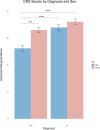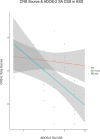Sex differences in the first impressions made by girls and boys with autism
- PMID: 32546266
- PMCID: PMC7298946
- DOI: 10.1186/s13229-020-00336-3
Sex differences in the first impressions made by girls and boys with autism
Abstract
Background: Individuals with autism spectrum disorder (ASD) are characterized by social communication challenges and repetitive behaviors that may be quickly detected by experts (Autism Res 10:653-62, 2017; American Psychiatric Association, Diagnostic and statistical manual of mental disorders, 2013). Recent research suggests that even naïve non-experts judge a variety of human dimensions using narrow windows of experience called "first impressions." Growing recognition of sex differences in a variety of observable behaviors in ASD, combined with research showing that some autistic girls and women may "camouflage" outward symptoms, suggests it may be more difficult for naïve conversation partners to detect ASD symptoms in girls. Here, we explore the first impressions made by boys and girls with ASD and typically developing (TD) peers.
Methods: Ninety-three school-aged children with ASD or TD were matched on IQ; autistic girls and boys were additionally matched on autism symptom severity using the ADOS-2. Participants completed a 5-minute "get-to-know-you" conversation with a new young adult acquaintance. Immediately after the conversation, confederates rated participants on a variety of dimensions. Our primary analysis compared conversation ratings between groups (ASD boys, ASD girls, TD boys, TD girls).
Results: Autistic girls were rated more positively than autistic boys by novel conversation partners (better perceived social communication ability), despite comparable autism symptom severity as rated by expert clinicians (equivalent true social communication ability). Boys with ASD were rated more negatively than typical boys and typical girls by novel conversation partners as well as expert clinicians. There was no significant difference in the first impressions made by autistic girls compared to typical girls during conversations with a novel conversation partner, but autistic girls were rated lower than typical girls by expert clinicians.
Limitations: This study cannot speak to the ways in which first impressions may differ for younger children, adults, or individuals who are not verbally fluent; in addition, there were more autistic boys than girls in our sample, making it difficult to detect small effects.
Conclusions: First impressions made during naturalistic conversations with non-expert conversation partners could-in combination with clinical ratings and parent report-shed light on the nature and effects of behavioral differences between girls and boys on the autism spectrum.
Keywords: Autism spectrum disorder; Camouflage; First impressions; Sex differences.
Conflict of interest statement
The authors declare that they have no competing interests.
Figures



References
-
- Dunn DS, Andrews EE. Person-first and identity-first language: Developing psychologists’ cultural competence using disability language. Am Psychol. 2015;70(3):255–264. - PubMed
-
- Kenny L, Hattersley C, Molins B, Buckley C, Povey C, Pellicano E. Which terms should be used to describe autism? Perspectives from the UK autism community. Autism. 2016;20(4):442–462. - PubMed
-
- American Psychiatric Association . Diagnostic and Statistical Manual of Mental Disorders, 5th Edition: DSM-5 (5 edition) Washington D.C.: American Psychiatric Publishing; 2013.
-
- Tobin MC, Drager KDR, Richardson LF. A systematic review of social participation for adults with autism spectrum disorders: Support, social functioning, and quality of life. Res Autism Spectr Disord. 2014;8(3):214–229.
-
- World Health Organization. Fact sheet on gender: key facts, impact on health, gender equality in health and WHO response: World Health Organization; 2015. Available from: http://www.who.int/news-room/fact-sheets/detail/gender. Cited 2018 Jul 26.
Publication types
MeSH terms
Grants and funding
LinkOut - more resources
Full Text Sources

